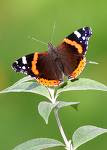

In two recent papers a former PhD student at Lund University, now postdoc in Leiden, Oskar Brattström and co-authors have used stable isotopes and AFLP technique to study the structure of population composition and pattern of migration of European red admirals (Vanessa atalanta) across Europe.
Brattström, O., Åkesson, S. and Bensch, S. 2010. AFLP reveals cryptic population structure in migratory European red admirals Vanessa atalanta. Ecol. Entomol. 35: 48-52. // DOI: 10.1111/j.1365-2311.2009.01163.x
AFLP profiles showed significant differences between almost all sampled locations, but there was no clear pattern of isolation-by-distance. We found two distinct genotype clusters present in different frequencies at all study sites. The frequencies of these genotypic clusters varied significantly between years within the same site. Remarkably few individuals were of mixed ancestry, indicating that some isolating mechanisms are present. Twenty-seven mtDNA haplotypes were identified but they showed no geographic structure, nor were they related to either of the two genotype clusters identified in the AFLP data. Our results suggest long, but more complex migration movements between years for this species. Most field observations of migrating red admirals suggest a regular north–south migration pattern in Europe. Our data indicate both long-distance migration and a more variable pattern in orientation, since the composition of the two genotypic clusters shows dramatic variation between sites and years in the northern part of the distribution range.
Brattström, O., Bensch, S., Wassenaar, L. I., Hobson, K. and Åkesson, S. 2010. Understanding the migration ecology of European red admirals Vanessa atalanta using stable hydrogen isotopes. Ecography // doi: 10.1111/j.1600-0587.2009.05748.x
We also show by using stable isotope that the variation in deuterium associated with a southwest-northeast gradient can be used to assign individual butterflies to general regions of origin. Tracking migratory movement of small animals with variable migration patterns is difficult with standard mark recapture methods or genetic analysis. We used stable hydrogen isotope (dD) measurements of wings from European red admirals Vanessa atalanta to study several aspects of this species’ migration. In the central part of southern Europe we found large differences in dD values between red admirals sampled in autumn and spring supporting the hypothesis that reproduction takes place in the Mediterranean region during winter. There was also an apparent influx to southern Europe in the spring of individuals with a more southerly origin, since many samples had higher dD values and similar to those expected from coastal areas of North Africa. We found a clear seasonal difference in the dD values of red admirals sampled in northern Europe. Spring migrants arriving in northern Europe generally had high dD values that indicated a southerly origin. In autumn, dD values suggested that red admirals were mostly from regions close to the sampling sites, but throughout the sampling period there were always individuals with dD values suggesting non-local origins. The migration pattern of this species is supposedly highly variable and plastic. dD differences between individuals in the western part of Europe were generally small making migratory patterns difficult to interpret. However, butterflies from western Europe were apparently isolated from those from north-eastern Europe, since dD values in the western region rarely corresponded to those of autumn migrants from the north-east. Use of dD data for inferring butterfly migration in Europe is complex, but our study showed that this technique can be used to help uncover previously unknown aspects of red admiral migration.
 A special issue published within the Journal of the Royal Society Interface presents a themed collection of papers on the topic "Magnetoreception". The recent issue aims to give an overview of current research activities in the interdisciplinary field of magnetoreception across different taxa, combining ample sub-disciplines within biology, chemistry, physics and material sciences.
A special issue published within the Journal of the Royal Society Interface presents a themed collection of papers on the topic "Magnetoreception". The recent issue aims to give an overview of current research activities in the interdisciplinary field of magnetoreception across different taxa, combining ample sub-disciplines within biology, chemistry, physics and material sciences.


